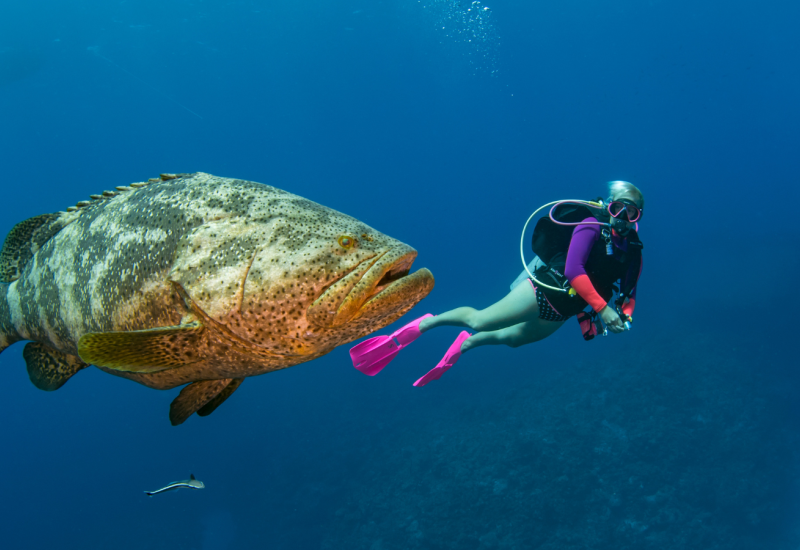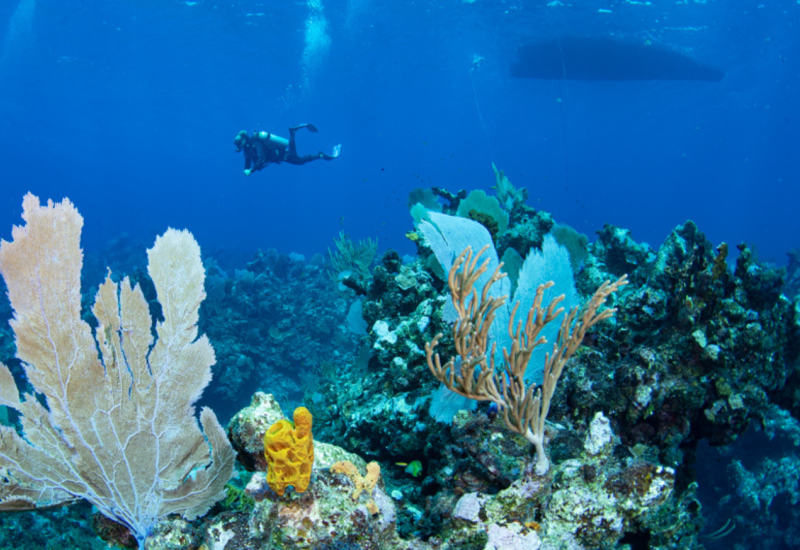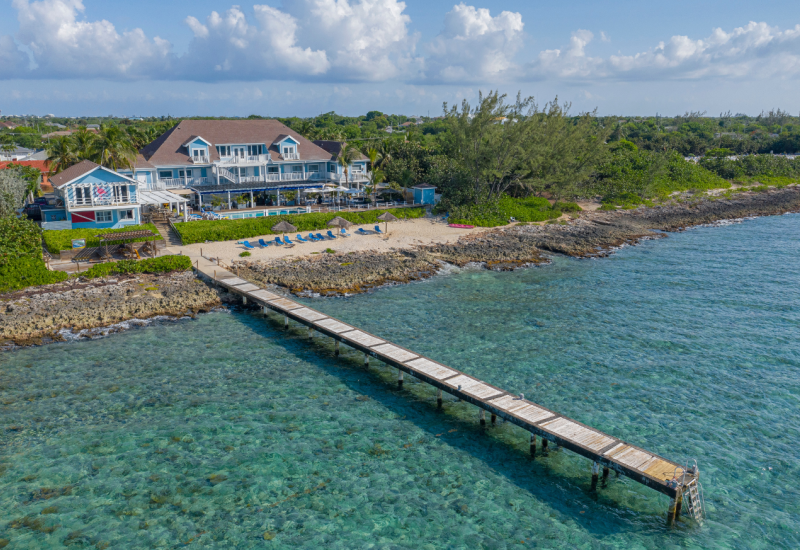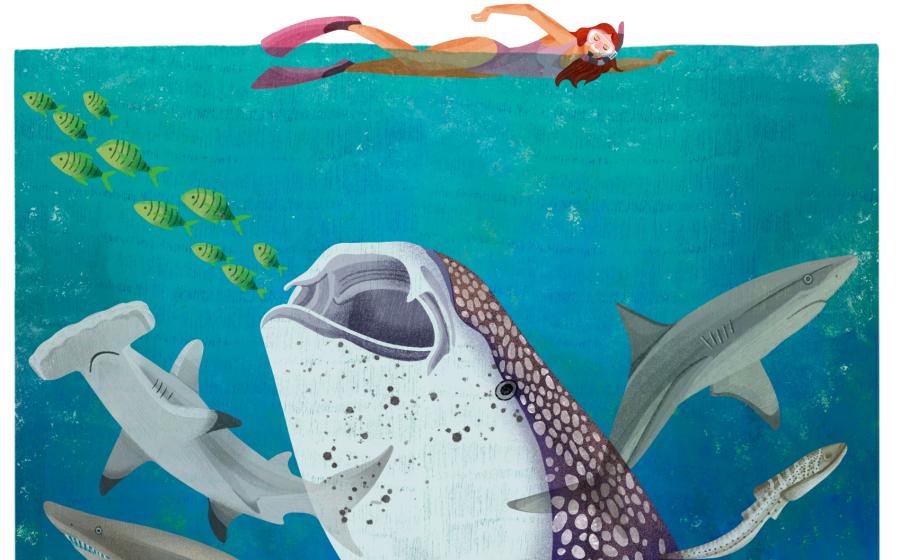A Match Made In the Cayman Islands

Snapper Hole, Grand Cayman
Ty Sawyer
There isn't a diver on the planet who wouldn't love diving on at least one of the three Cayman Islands. Grand Cayman, Cayman Brac and Little Cayman offer sublime wall diving, clear visibility, healthy reefs, decent wreck diving and easy shore diving. But if you're planning a complete dive vacation package, you need to know what these islands offer besides great diving. Each has a distinct vacation personality: Grand Cayman boasts a well-established tourism infrastructure, including shopping, restaurants and nightlife; Cayman Brac's rugged interior provides a host of hiking and climbing opportunities; and Little Cayman, with a population of about 200, is your chance to get away from it all and find solitude. Whether you like shallow reefs or deep walls, a vibrant nightlife or napping in a hammock, you'll find what you're looking for in the Cayman Islands. Can't decide? Our travel guide can help you find your perfect match.
Grand Cayman

Grand Cayman
Lisa Adams
Perfect Match For
Divers who want a vacation that is equal parts underwater excitement and topside fun.
For families because you can take the kids snorkeling at Stingray City or beach-bumming on one of the world's most famous strands, Seven Mile Beach.
For singles who will enjoy the nightlife — the island offers a wide variety of bars and restaurants.
I'm with a group of photographers making a leisurely tour of Cinderella's Castle on the northeast side of Grand Cayman's East End, a deliciously intricate maze of deep cuts, passageways and tunnels. At every turn, there's a passageway to another part of this labyrinthine reef system, lushly adorned with purple deep-water sea fans and bushy sea plumes. Horse-eye jacks and tarpon shelter in recesses and cracks in the reef and provide reliable photo ops.
In fact, the jaw-dropping, Grand Canyonesque topography that defines the deep reefs and walls off Grand Cayman — whether the North Shore, West End or East End — guarantees stunning underwater images. This 22- by eight-mile pancake-flat island is anything but level underwater — more than 150 dive sites ring the island, many of them featuring precipitous walls, towering canyons and reefs laced with swim-throughs.
The most popular area to dive on Grand Cayman is off Seven Mile Beach on the island's West End. Many of the sites here are the stuff of legend — Orange Canyon, Trinity Caves, Eagle Ray Rock and Aquarium — and start in just 50 or 60 feet of calm blue water. Orange Canyon is located on the North Wall just south of North West Point--think underwater Badlands National Park with its towering formations, only completely covered in elephant ear sponges and bursting with color. Bonnie's Arch, about 150 feet from Orange Canyon, is a broad-beamed coral arch that was once home to an impressive school of tarpon — local divemasters say the tarpon relocated after Hurricane Ivan hit in 2004. The fish may be no-shows, but sizeable congregations of horse-eye jacks gather on the reef here.
Not surprisingly, the West Bay site Trinity Caves is not only the most requested site off West End, it's arguably the most popular dive on Grand Cayman. It's a striking system of narrow passageways and small canyons that run perpendicular to shore and lead you out to the wall at about 100 feet. One of the canyons deposits you into the blue depths where a breathtaking pinnacle rises from the seafloor. You can spend the entire dive lazily finning in and out of canyons and swim-throughs, slowly making your way back to the reeftop.
North Shore diving — off the island's northwest coast — is characterized by the shallow sites found in North Sound and the steep drop-offs along North Wall. White Stroke Canyon on the North Wall has a wall covered in black corals and sponges, but keep an eye on your depth; the drop-off plunges way beyond recreational diving limits.
Stingray City, Grand Cayman's world-famous animal encounter, is in only 12 feet of water in North Sound. The southern stingrays will expect bits of squid from the snorkelers who frequent a nearby site called Sandbar. You can't dive on scuba at Sandbar, but try to find a dive operator who is willing to take you there to snorkel at dawn — at this early hour, the cruise ship visitors haven't arrived yet, so the rays won't mob you for free sushi. Instead, they'll glide past you in small schools, offering great opportunities for photographers — early morning light, an undisturbed sand bottom and close encounters with these graceful animals.
The East End is exposed to more wind, current and surf than the West End, but sites clustered on the southeast and northeast corners provide shelter from the worst conditions. At Split Rock, on the northeast wall, you'll drop down under the boat and swim to a deep split in the reef — hence the name — and out to the wall, at about 85 feet or so. The walls of the fissure soar upward. Once out in the blue, along the drop-off's face, you can descend a bit deeper, to 110 feet or so, to find healthy corals and gorgonians on every inch of the wall. Bring a light to peek into the many nooks and crannies.
Best Shore Dive Eden Rock and Devil's Grotto offer caverns jammed with marine life. Look for schools of silversides and tarpon in the recesses.
Best Night Dive Dive the remains of the small freighter Balboa, in 30 feet of water at George Town Harbour's entrance, when the sun sets. Octopuses, crabs and squid will all be out.
Best Beach Seven Mile Beach is, of course, the island's most popular beach, but if you're looking for a more secluded place to sunbathe or picnic, head to Smith's Cove (south of George Town).
Best Topside Excursions
(1) Cayman Turtle Farm: This attraction features an artificial saltwater coral reef for snorkeling, an aviary for 60 species of birds, a predator tank with sharks and eels (which will be viewed “underwater” from behind acrylic windows), a nature trail where hikers can encounter Caymanian flora and fauna, and a street lined with replicas of historic Cayman houses. For More: Grand Cayman Turtle Farm.
(2) Pedro St. James National Historic Site: Take a tour of this plantation-style house, originally built in 1780 by William Eden, and the property, which overlooks the sea. There is also a state-of-the-art multimedia theater. Located 15 minutes from George Town. For More: Pedro St. James.
(3) Queen Elizabeth II Botanic Park: A lush 65-acre tropical oasis with a scenic trail, gardens and habitat for blue iguanas. Fore More: Queen Elizabeth II Botanic Park.
Little Cayman

Little Cayman
Lisa Adams
Perfect Match For
Those seeking solitude. If you want to get away from cell phones, reality TV and your boss, sweet-natured Little Cayman is for you.
The smallest of the three Cayman islands, Little Cayman has only one industry — diving — for two world-renowned, pulse-quickening reasons: Bloody Bay and Jackson Bight walls. Otherwise, the state of mind on laid-back Little Cayman is relaxed. Iguanas have the right of way when they cross the island's only road. Seriously.
On Little Cayman's North Shore and starting in as little as 20 of water, Bloody Bay Wall is lavishly decorated with exotic sea fans and hardpan coral formations. The intersection of Bloody Bay Wall with the drop-off of Jackson Bight is known as Mixing Bowl, a favorite among divers. The drop-off from the reef leads to a sloping sand flat with a vibrant mini-wall where you can explore swim-throughs. Even the shallow part of this dive is worthwhile: jacks, chromis, grunts and snappers converge in good-sized schools on the reeftop.
Marilyn's Cut is also called Hole in the Wall, but no matter how you record it in your dive log it's a dramatic, sponge-cloaked site with two enormous fissures. The crevices start in about 50 feet of water and bottom out on a sandy ledge at 75 feet. At one time, Nassau groupers were fed at this site, and these friendly fish still show up in decent numbers once divers hit the water.
Best Shore Dive It's a long but easy swim to the mini-wall at Cumber's Caves, west of Jackson Bay. The dive starts in 18 feet of water.
Best Night Dive You'll use your dive light on the Soto Trader to peer into portholes and explore the reef just off the bow to find nocturnal squid, lobster and squirrelfish.
Best Beach Swim, snorkel and picnic at secluded Point of Sand, off the southeast coast near Sandy Point Pond.
Best Topside Excursions
(1) Booby Pond Nature Reserve: A protected wetlands and nesting ground for 20,000 red-footed boobies. The viewing platform of the National Trust Building, which offers telescopes, is the best place to view them and the rare West Indian whistling duck. Stop by for homemade ice cream and tea at the
(2) Owen Island: This islet in South Hole Lagoon, just off Little Cayman's south coast, is ideal for family picnics. Don't forget your masks and fins: You'll find silversides, jacks and bonefish in clear, shallow water.
(3) Tarpon Lake: It's strictly catch and release for anglers in these knee-deep, mangrove-surrounded shallows.
Cayman Brac

Cayman Brac
Lisa Adams
Perfect Match For
Those looking for a combination of adventure and quiet. Visitors looking for a respite from their everyday stresses will appreciate Cayman Brac's unhurried ambience and physical beauty. A steep, 140-foot limestone bluff dominates the Brac's eastern end, offering panoramic views, hiking trails, caves to explore and climbing opportunities.
Twelve miles long and a mere mile wide, Cayman Brac boasts two shores of top-notch wall diving. Prevailing wind conditions make the north side of the island the predominant dive side. Here, sand chutes lead to the drop-off at 50 feet and the wall features more sponge life with big barrel, strawberry and vase sponges. The southern wall is topped by spur-and-groove corals and offers sheer drop-offs.
The fabled 330-foot Russian warship, the MV Capt. Keith Tibbetts, catapulted the Brac to the top of the list for many wreck diving aficionados after it was sunk in 1996. Sitting in relatively shallow depths, in 50 to 80 feet of water, the wreck is visited by barracudas that patrol the bridge and upper decks. Make sure you've got a wide-angle lens on your camera to photograph the vessel's impressive turret guns.
Strawberry Sponge Wall, also on the island's north side, could have been named for any of the sponges found on the drop-off-tube, stovepipe and row-pore find purchase here along with the strawberry vase sponges that give the site its name.
Check out the progress on the Lost City of Atlantis, an underwater sculpture project in 50 feet of water on the island's north side, not far from Radar Reef.
Best Shore Dive Easy access makes Radar Reef, in Stake Bay, a shore diving winner: You'll find an entertaining collection of macro critters if you stay shallow.
Best Night Dive A host of big-eyed squirrelfish gets busy on the Cayman Mariner when the sun sets. Just off the wreck's bow is East Chute Reef.
Best Beach Sunscreen, a book and a kick-off-your-sandals frame of mind are all you need on the southeast beaches of Hawksbill Bay.
Best Topside Excursions
(1) The Bluff: If you're a serious climber and have your own gear, you can climb the craggy cliffs at the Bluff's scenic easternmost point. You can tone down the adventure a bit and hike one of the trails or explore any of the cool, dark caves sculpted into its sides. www.naturecayman.ky.
(2) Cayman Brac Museum: Located in Stake Bay, the museum is a good place to learn about the island's early history.
(3) Brac Parrot Reserve: Bring your binoculars to spot the endangered and colorful Brac parrot.
In Depth
Dive Conditions: The average water temperature is between 79 and 83 degrees, and the visibility is often greater than 100 feet.
Weather: The Cayman Islands' tropical climate is cooled by trade winds in winter; the rain picks up in summer months, but it usually appears in brief spurts. Temperatures generally range from 75 to 85 degrees, with highs up to 90 in the summer.
Getting There: Scheduled flights to Grand Cayman's Owen Roberts International Airport are available on multiple airlines. Cayman Brac also has its own airport, Gerrard Smith International. Little Cayman is served by daily inter-island flights.
Getting Around: Renting a car is a must if you want to explore Grand Cayman. Most of the big chains have offices at the airport. The Cayman Islands Tourism web site has a link to car rental agencies.
Documents: U.S. visitors need a valid passport. Keep the immigration slip issued to you — you'll need to return it upon your departure. The departure tax is usually included in the price of your airline ticket.
Language: English.
Time: Eastern Standard Time year-round; Daylight Saving Time is not observed.
Telephone: The area code is 345.
Currency: The Cayman Islands dollar (CI) is on a fixed exchange rate: CI$1 is equal to US$1.25.
Electricity: 110 volts, 60 cycles, the same as in the U.S.
Dive Operators: For detailed information on Cayman Islands dive operators, comprehensive travel guides, special dive deals and recent trip reports submitted by users, check out the Cayman Islands Tourism web site.

Stephen FrinkHundreds of silversides congregate in a cavern at Leslie's Curl, on Grand Cayman's North Wall.
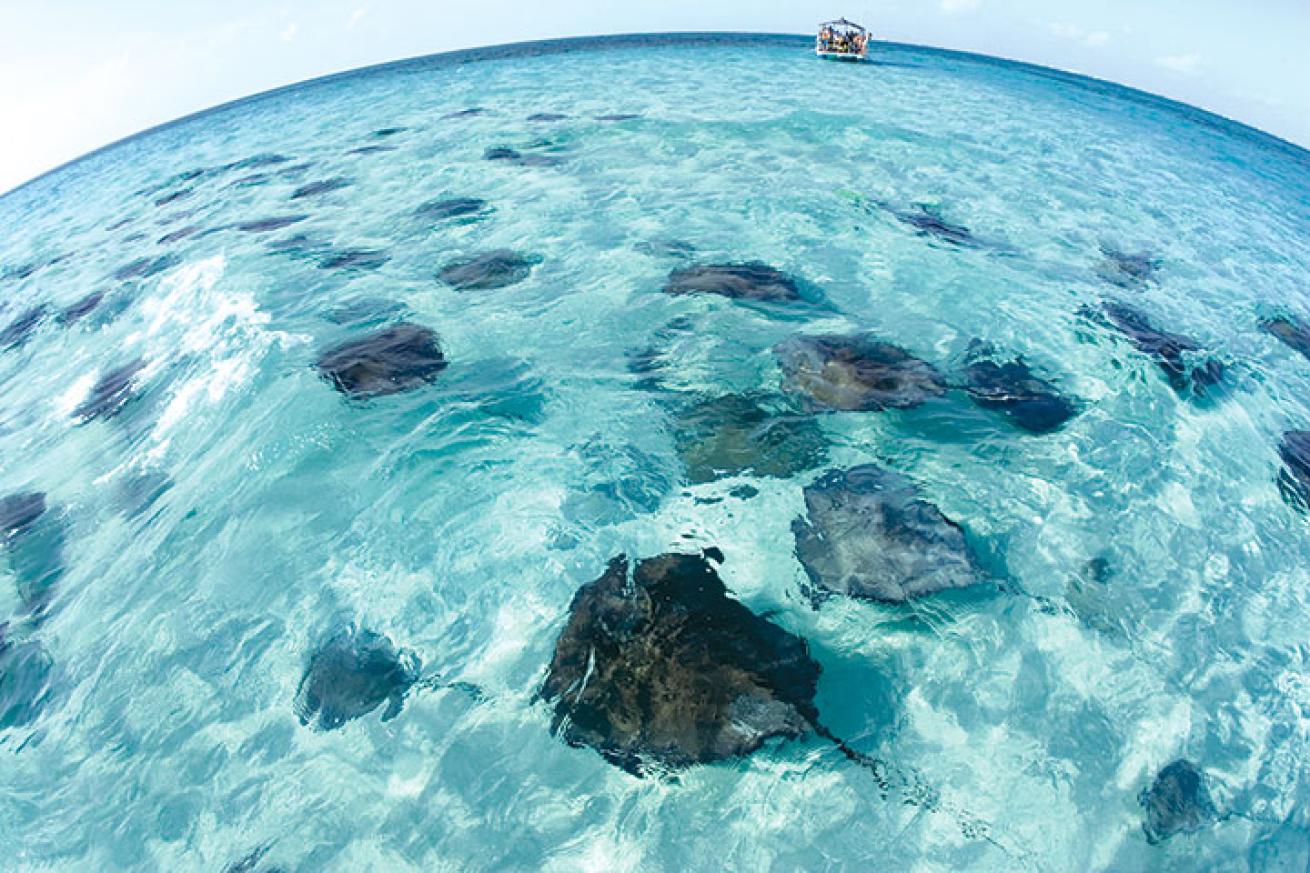
Stephen FrinkThe stingray encounter at Grand Cayman's Sandbar site in North Sound.
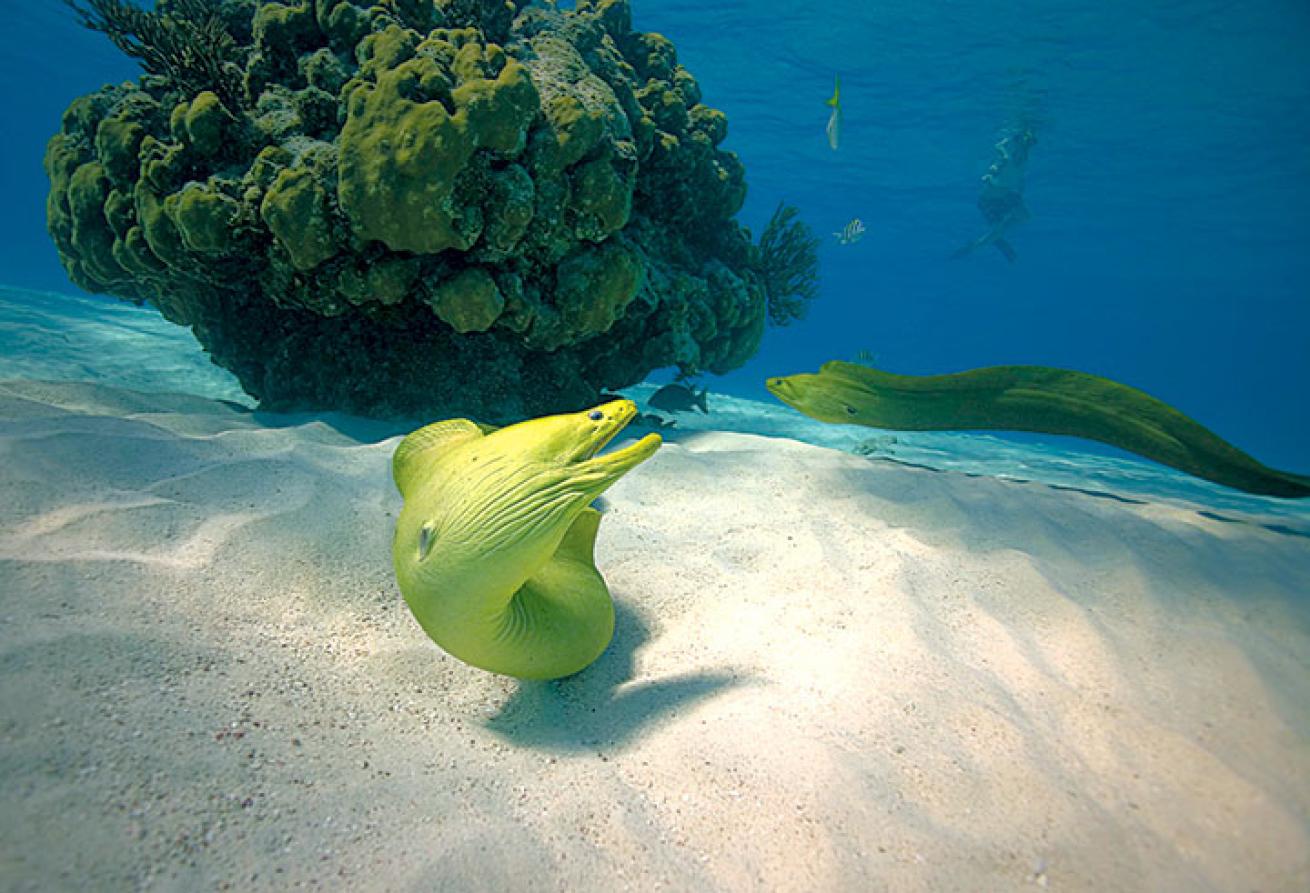
Stephen FrinkAnother denizen found on a Grand Cayman reef.
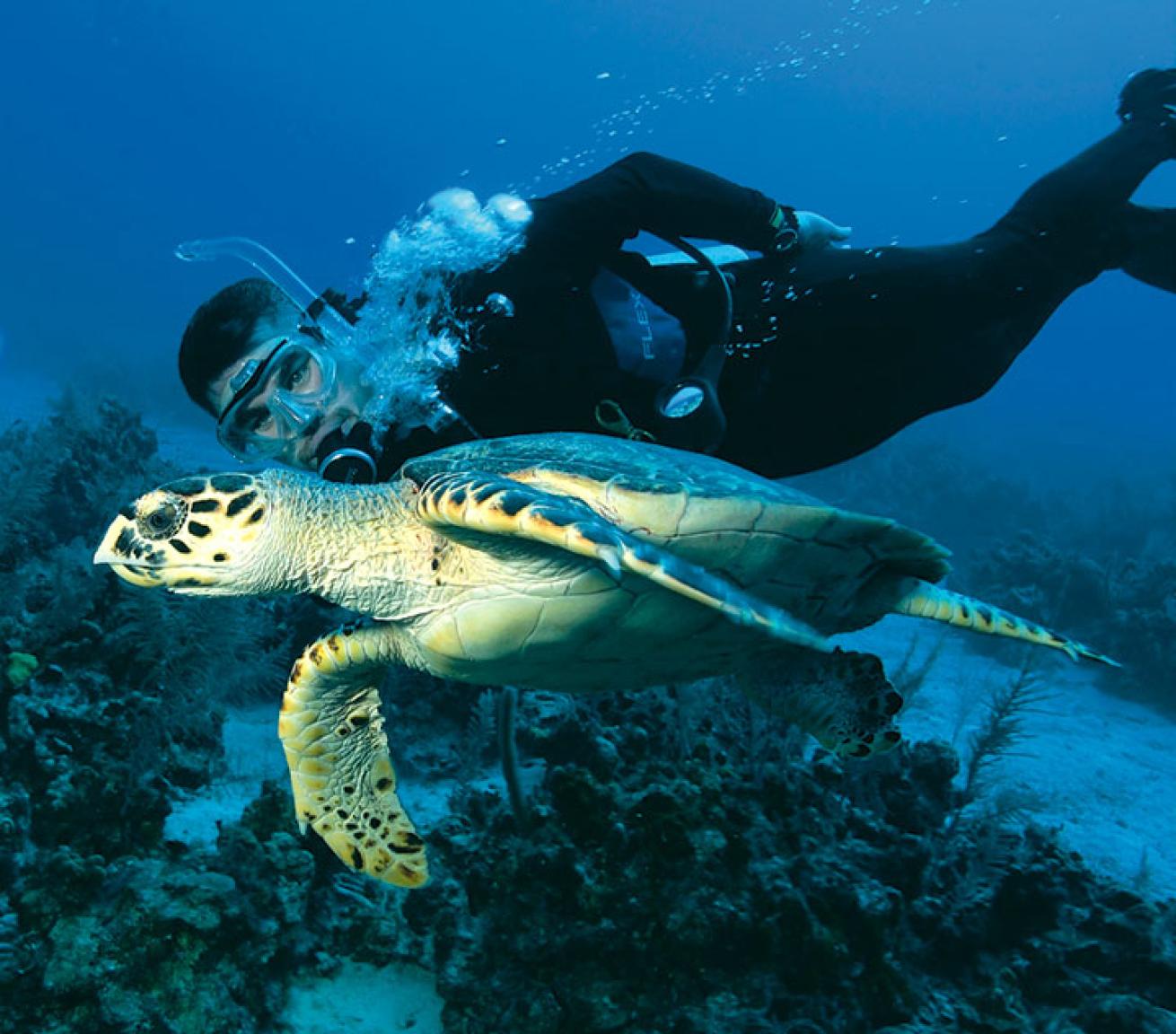
Stephen FrinkTurtle encounters are common off Grand Cayman.
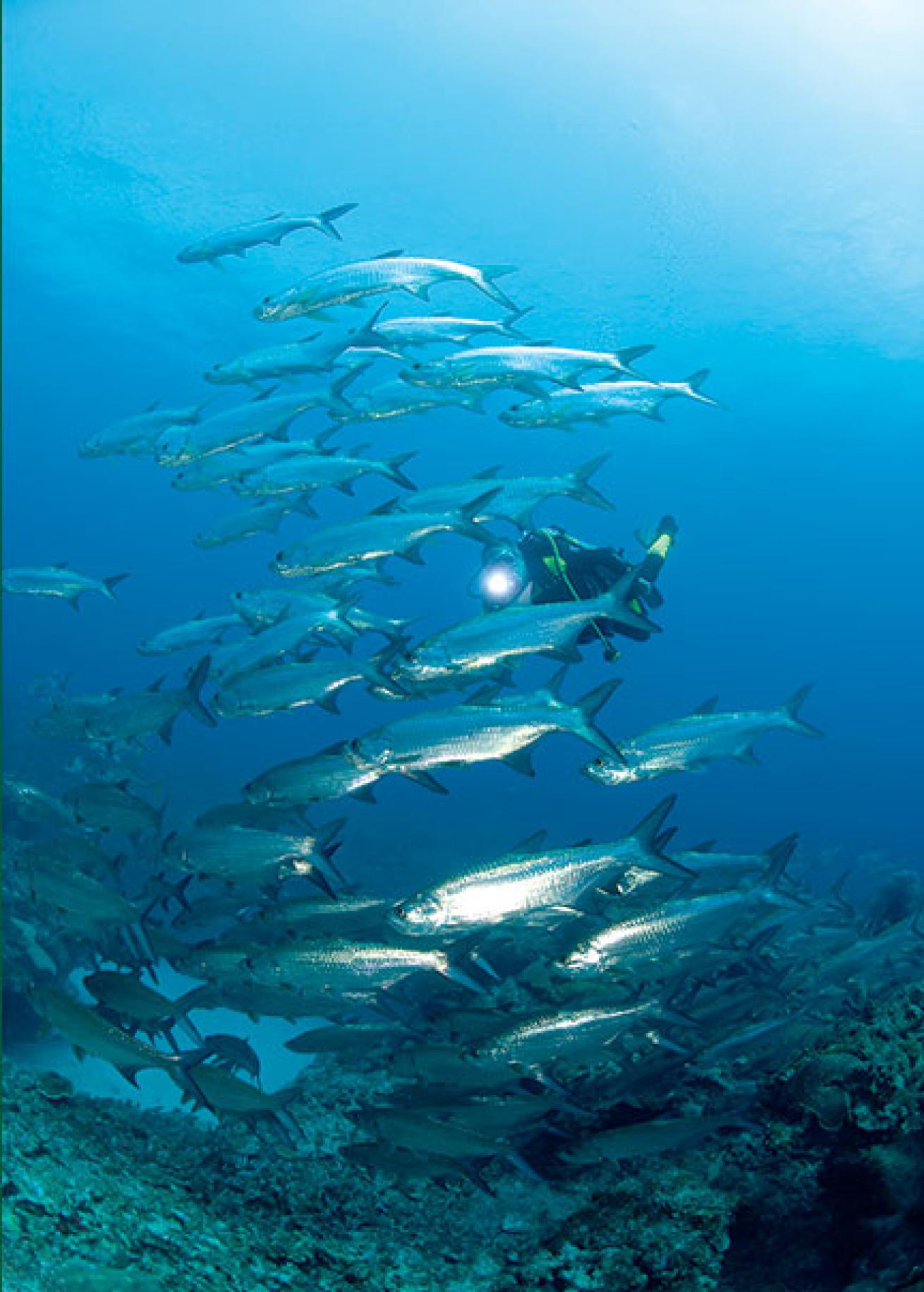
Stephen FrinkTarpon at Chub Hole, off Grand Cayman's East End.
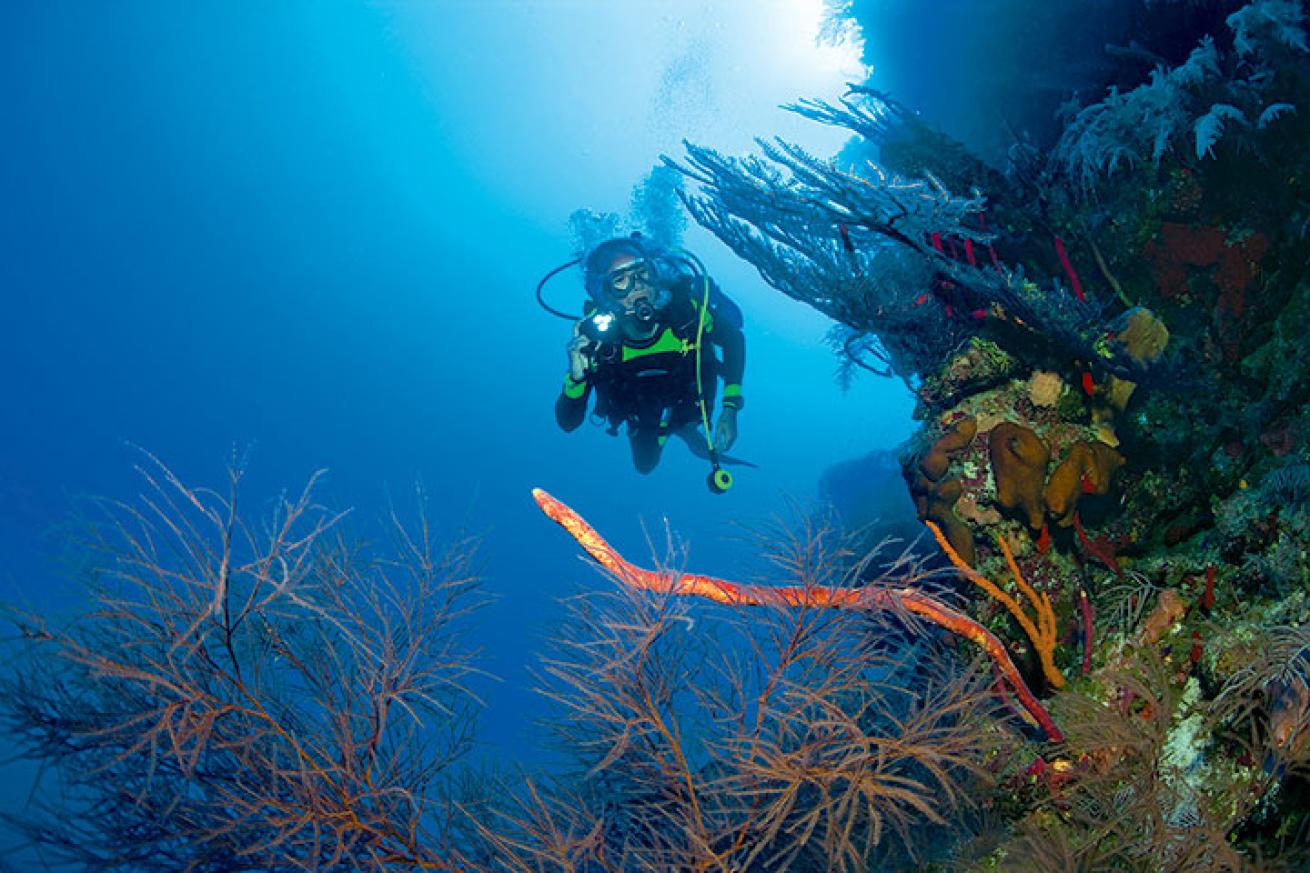
Stephen FrinkHealthy stands of corals and gorgonians populate Little Cayman's wall.
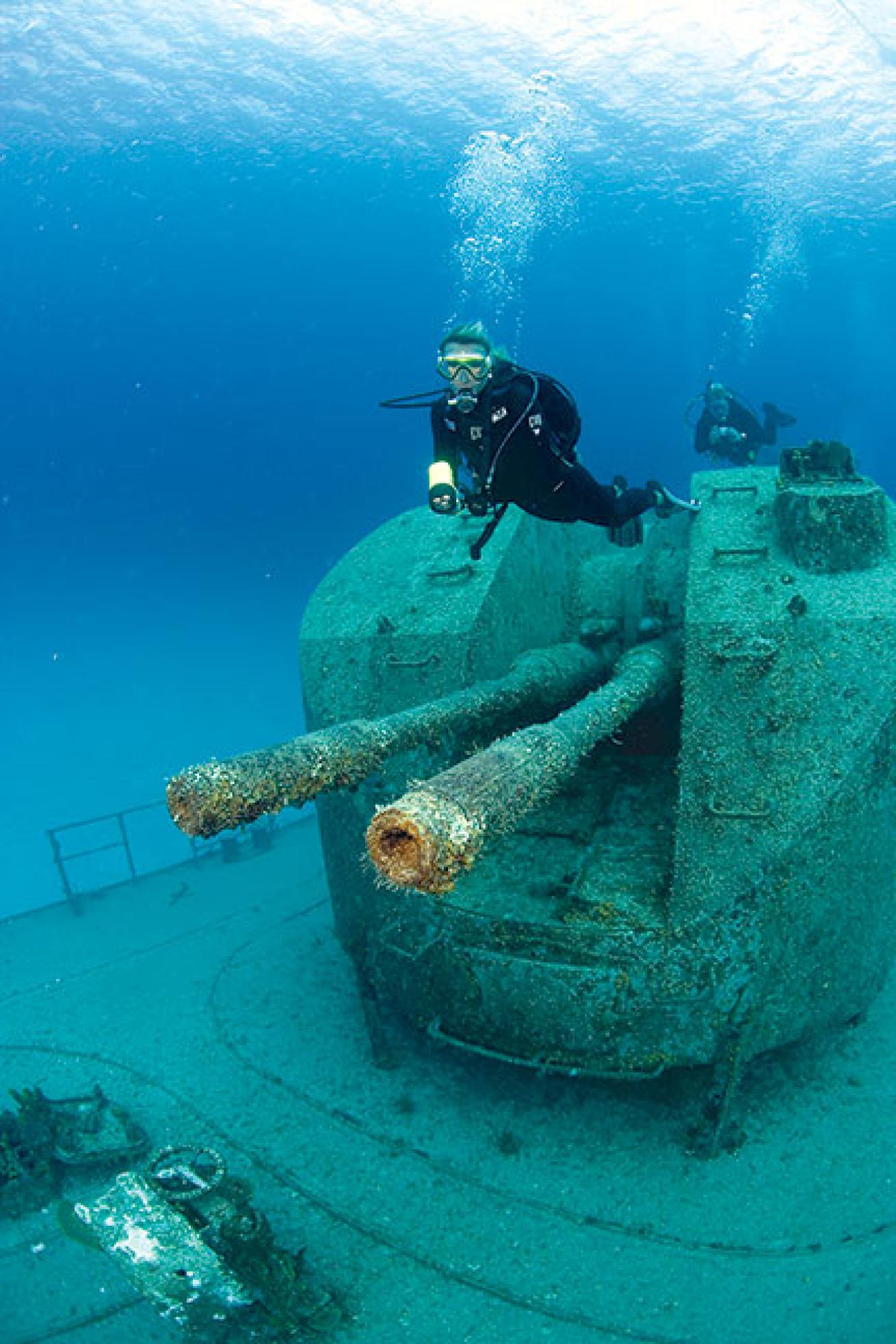
Stephen FrinkThe Tibbetts's guns make for an exciting photo opp.
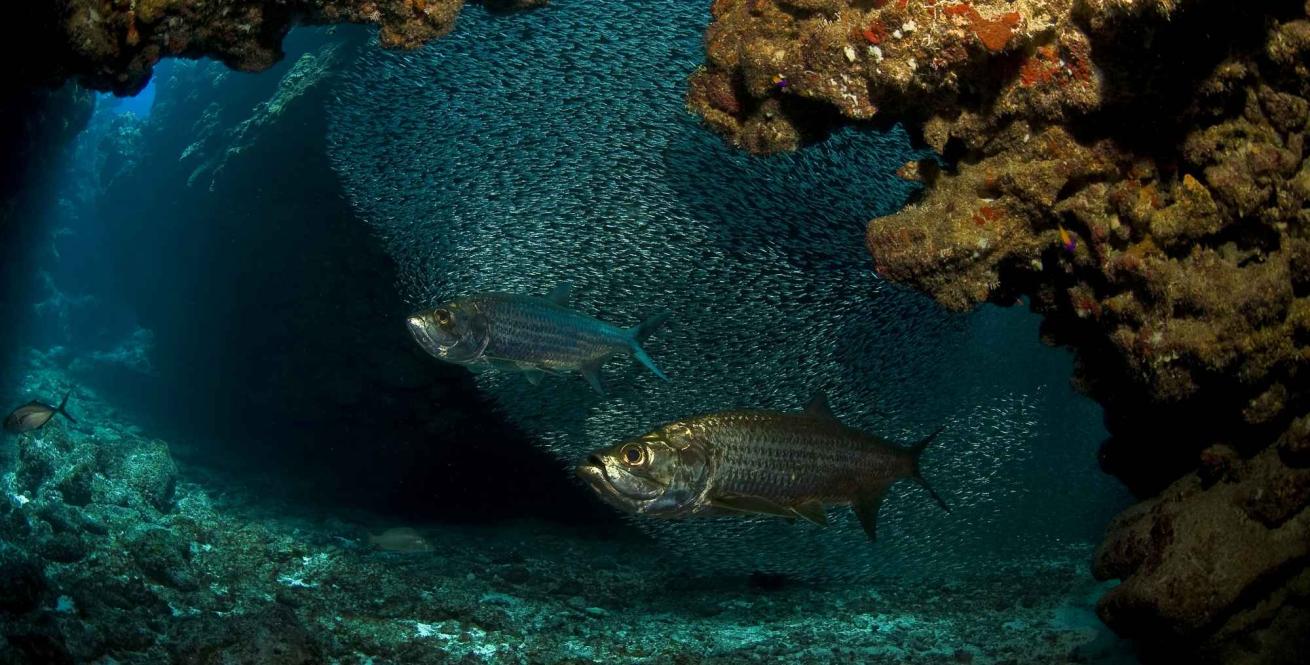
Ty SawyerSnapper Hole, Grand Cayman
There isn't a diver on the planet who wouldn't love diving on at least one of the three Cayman Islands. Grand Cayman, Cayman Brac and Little Cayman offer sublime wall diving, clear visibility, healthy reefs, decent wreck diving and easy shore diving. But if you're planning a complete dive vacation package, you need to know what these islands offer besides great diving. Each has a distinct vacation personality: Grand Cayman boasts a well-established tourism infrastructure, including shopping, restaurants and nightlife; Cayman Brac's rugged interior provides a host of hiking and climbing opportunities; and Little Cayman, with a population of about 200, is your chance to get away from it all and find solitude. Whether you like shallow reefs or deep walls, a vibrant nightlife or napping in a hammock, you'll find what you're looking for in the Cayman Islands. Can't decide? Our travel guide can help you find your perfect match.
Grand Cayman
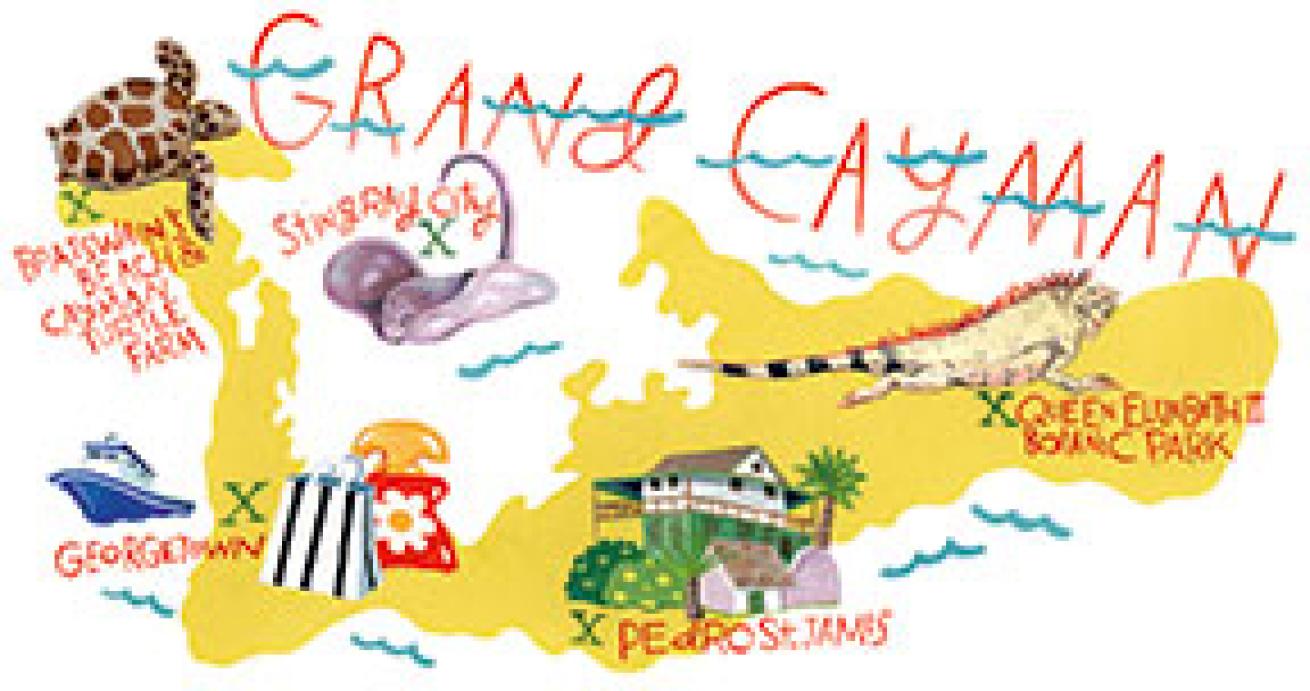
Lisa Adams
Perfect Match For
Divers who want a vacation that is equal parts underwater excitement and topside fun.
For families because you can take the kids snorkeling at Stingray City or beach-bumming on one of the world's most famous strands, Seven Mile Beach.
For singles who will enjoy the nightlife — the island offers a wide variety of bars and restaurants.
I'm with a group of photographers making a leisurely tour of Cinderella's Castle on the northeast side of Grand Cayman's East End, a deliciously intricate maze of deep cuts, passageways and tunnels. At every turn, there's a passageway to another part of this labyrinthine reef system, lushly adorned with purple deep-water sea fans and bushy sea plumes. Horse-eye jacks and tarpon shelter in recesses and cracks in the reef and provide reliable photo ops.
In fact, the jaw-dropping, Grand Canyonesque topography that defines the deep reefs and walls off Grand Cayman — whether the North Shore, West End or East End — guarantees stunning underwater images. This 22- by eight-mile pancake-flat island is anything but level underwater — more than 150 dive sites ring the island, many of them featuring precipitous walls, towering canyons and reefs laced with swim-throughs.
The most popular area to dive on Grand Cayman is off Seven Mile Beach on the island's West End. Many of the sites here are the stuff of legend — Orange Canyon, Trinity Caves, Eagle Ray Rock and Aquarium — and start in just 50 or 60 feet of calm blue water. Orange Canyon is located on the North Wall just south of North West Point--think underwater Badlands National Park with its towering formations, only completely covered in elephant ear sponges and bursting with color. Bonnie's Arch, about 150 feet from Orange Canyon, is a broad-beamed coral arch that was once home to an impressive school of tarpon — local divemasters say the tarpon relocated after Hurricane Ivan hit in 2004. The fish may be no-shows, but sizeable congregations of horse-eye jacks gather on the reef here.
Not surprisingly, the West Bay site Trinity Caves is not only the most requested site off West End, it's arguably the most popular dive on Grand Cayman. It's a striking system of narrow passageways and small canyons that run perpendicular to shore and lead you out to the wall at about 100 feet. One of the canyons deposits you into the blue depths where a breathtaking pinnacle rises from the seafloor. You can spend the entire dive lazily finning in and out of canyons and swim-throughs, slowly making your way back to the reeftop.
North Shore diving — off the island's northwest coast — is characterized by the shallow sites found in North Sound and the steep drop-offs along North Wall. White Stroke Canyon on the North Wall has a wall covered in black corals and sponges, but keep an eye on your depth; the drop-off plunges way beyond recreational diving limits.
Stingray City, Grand Cayman's world-famous animal encounter, is in only 12 feet of water in North Sound. The southern stingrays will expect bits of squid from the snorkelers who frequent a nearby site called Sandbar. You can't dive on scuba at Sandbar, but try to find a dive operator who is willing to take you there to snorkel at dawn — at this early hour, the cruise ship visitors haven't arrived yet, so the rays won't mob you for free sushi. Instead, they'll glide past you in small schools, offering great opportunities for photographers — early morning light, an undisturbed sand bottom and close encounters with these graceful animals.
The East End is exposed to more wind, current and surf than the West End, but sites clustered on the southeast and northeast corners provide shelter from the worst conditions. At Split Rock, on the northeast wall, you'll drop down under the boat and swim to a deep split in the reef — hence the name — and out to the wall, at about 85 feet or so. The walls of the fissure soar upward. Once out in the blue, along the drop-off's face, you can descend a bit deeper, to 110 feet or so, to find healthy corals and gorgonians on every inch of the wall. Bring a light to peek into the many nooks and crannies.
Best Shore Dive Eden Rock and Devil's Grotto offer caverns jammed with marine life. Look for schools of silversides and tarpon in the recesses.
Best Night Dive Dive the remains of the small freighter Balboa, in 30 feet of water at George Town Harbour's entrance, when the sun sets. Octopuses, crabs and squid will all be out.
Best Beach Seven Mile Beach is, of course, the island's most popular beach, but if you're looking for a more secluded place to sunbathe or picnic, head to Smith's Cove (south of George Town).
Best Topside Excursions
(1) Cayman Turtle Farm: This attraction features an artificial saltwater coral reef for snorkeling, an aviary for 60 species of birds, a predator tank with sharks and eels (which will be viewed “underwater” from behind acrylic windows), a nature trail where hikers can encounter Caymanian flora and fauna, and a street lined with replicas of historic Cayman houses. For More: Grand Cayman Turtle Farm.
(2) Pedro St. James National Historic Site: Take a tour of this plantation-style house, originally built in 1780 by William Eden, and the property, which overlooks the sea. There is also a state-of-the-art multimedia theater. Located 15 minutes from George Town. For More: Pedro St. James.
(3) Queen Elizabeth II Botanic Park: A lush 65-acre tropical oasis with a scenic trail, gardens and habitat for blue iguanas. Fore More: Queen Elizabeth II Botanic Park.
Little Cayman
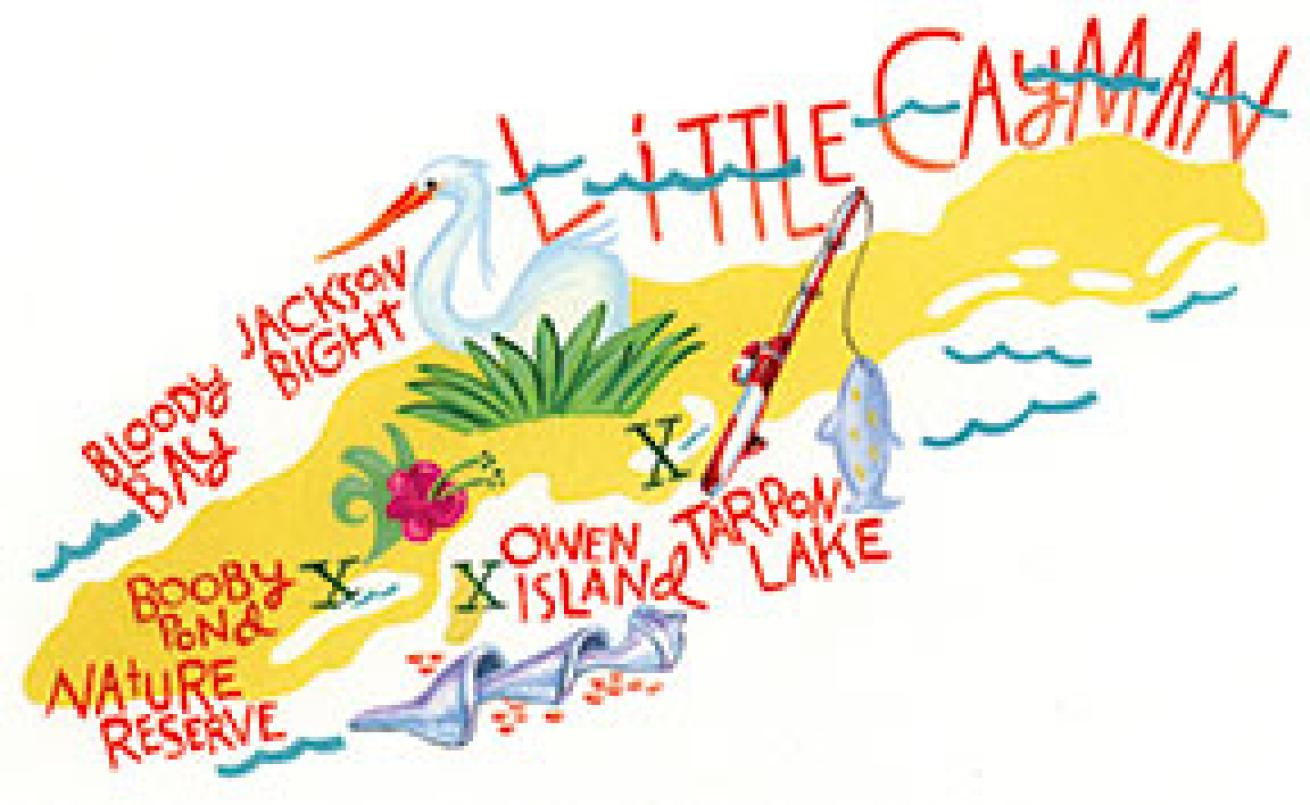
Lisa Adams
Perfect Match For
Those seeking solitude. If you want to get away from cell phones, reality TV and your boss, sweet-natured Little Cayman is for you.
The smallest of the three Cayman islands, Little Cayman has only one industry — diving — for two world-renowned, pulse-quickening reasons: Bloody Bay and Jackson Bight walls. Otherwise, the state of mind on laid-back Little Cayman is relaxed. Iguanas have the right of way when they cross the island's only road. Seriously.
On Little Cayman's North Shore and starting in as little as 20 of water, Bloody Bay Wall is lavishly decorated with exotic sea fans and hardpan coral formations. The intersection of Bloody Bay Wall with the drop-off of Jackson Bight is known as Mixing Bowl, a favorite among divers. The drop-off from the reef leads to a sloping sand flat with a vibrant mini-wall where you can explore swim-throughs. Even the shallow part of this dive is worthwhile: jacks, chromis, grunts and snappers converge in good-sized schools on the reeftop.
Marilyn's Cut is also called Hole in the Wall, but no matter how you record it in your dive log it's a dramatic, sponge-cloaked site with two enormous fissures. The crevices start in about 50 feet of water and bottom out on a sandy ledge at 75 feet. At one time, Nassau groupers were fed at this site, and these friendly fish still show up in decent numbers once divers hit the water.
Best Shore Dive It's a long but easy swim to the mini-wall at Cumber's Caves, west of Jackson Bay. The dive starts in 18 feet of water.
Best Night Dive You'll use your dive light on the Soto Trader to peer into portholes and explore the reef just off the bow to find nocturnal squid, lobster and squirrelfish.
Best Beach Swim, snorkel and picnic at secluded Point of Sand, off the southeast coast near Sandy Point Pond.
Best Topside Excursions
(1) Booby Pond Nature Reserve: A protected wetlands and nesting ground for 20,000 red-footed boobies. The viewing platform of the National Trust Building, which offers telescopes, is the best place to view them and the rare West Indian whistling duck. Stop by for homemade ice cream and tea at the
(2) Owen Island: This islet in South Hole Lagoon, just off Little Cayman's south coast, is ideal for family picnics. Don't forget your masks and fins: You'll find silversides, jacks and bonefish in clear, shallow water.
(3) Tarpon Lake: It's strictly catch and release for anglers in these knee-deep, mangrove-surrounded shallows.
Cayman Brac
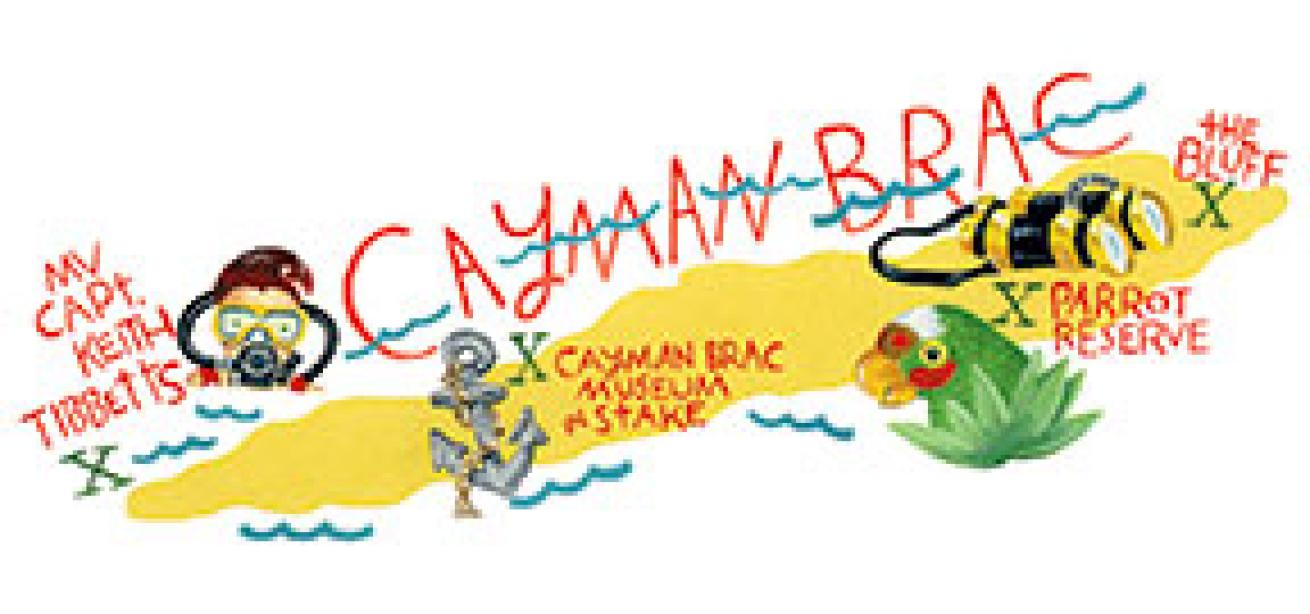
Lisa Adams
Perfect Match For
Those looking for a combination of adventure and quiet. Visitors looking for a respite from their everyday stresses will appreciate Cayman Brac's unhurried ambience and physical beauty. A steep, 140-foot limestone bluff dominates the Brac's eastern end, offering panoramic views, hiking trails, caves to explore and climbing opportunities.
Twelve miles long and a mere mile wide, Cayman Brac boasts two shores of top-notch wall diving. Prevailing wind conditions make the north side of the island the predominant dive side. Here, sand chutes lead to the drop-off at 50 feet and the wall features more sponge life with big barrel, strawberry and vase sponges. The southern wall is topped by spur-and-groove corals and offers sheer drop-offs.
The fabled 330-foot Russian warship, the MV Capt. Keith Tibbetts, catapulted the Brac to the top of the list for many wreck diving aficionados after it was sunk in 1996. Sitting in relatively shallow depths, in 50 to 80 feet of water, the wreck is visited by barracudas that patrol the bridge and upper decks. Make sure you've got a wide-angle lens on your camera to photograph the vessel's impressive turret guns.
Strawberry Sponge Wall, also on the island's north side, could have been named for any of the sponges found on the drop-off-tube, stovepipe and row-pore find purchase here along with the strawberry vase sponges that give the site its name.
Check out the progress on the Lost City of Atlantis, an underwater sculpture project in 50 feet of water on the island's north side, not far from Radar Reef.
Best Shore Dive Easy access makes Radar Reef, in Stake Bay, a shore diving winner: You'll find an entertaining collection of macro critters if you stay shallow.
Best Night Dive A host of big-eyed squirrelfish gets busy on the Cayman Mariner when the sun sets. Just off the wreck's bow is East Chute Reef.
Best Beach Sunscreen, a book and a kick-off-your-sandals frame of mind are all you need on the southeast beaches of Hawksbill Bay.
Best Topside Excursions
(1) The Bluff: If you're a serious climber and have your own gear, you can climb the craggy cliffs at the Bluff's scenic easternmost point. You can tone down the adventure a bit and hike one of the trails or explore any of the cool, dark caves sculpted into its sides. www.naturecayman.ky.
(2) Cayman Brac Museum: Located in Stake Bay, the museum is a good place to learn about the island's early history.
(3) Brac Parrot Reserve: Bring your binoculars to spot the endangered and colorful Brac parrot.
In Depth
Dive Conditions: The average water temperature is between 79 and 83 degrees, and the visibility is often greater than 100 feet.
Weather: The Cayman Islands' tropical climate is cooled by trade winds in winter; the rain picks up in summer months, but it usually appears in brief spurts. Temperatures generally range from 75 to 85 degrees, with highs up to 90 in the summer.
Getting There: Scheduled flights to Grand Cayman's Owen Roberts International Airport are available on multiple airlines. Cayman Brac also has its own airport, Gerrard Smith International. Little Cayman is served by daily inter-island flights.
Getting Around: Renting a car is a must if you want to explore Grand Cayman. Most of the big chains have offices at the airport. The Cayman Islands Tourism web site has a link to car rental agencies.
Documents: U.S. visitors need a valid passport. Keep the immigration slip issued to you — you'll need to return it upon your departure. The departure tax is usually included in the price of your airline ticket.
Language: English.
Time: Eastern Standard Time year-round; Daylight Saving Time is not observed.
Telephone: The area code is 345.
Currency: The Cayman Islands dollar (CI) is on a fixed exchange rate: CI$1 is equal to US$1.25.
Electricity: 110 volts, 60 cycles, the same as in the U.S.
Dive Operators: For detailed information on Cayman Islands dive operators, comprehensive travel guides, special dive deals and recent trip reports submitted by users, check out the Cayman Islands Tourism web site.

